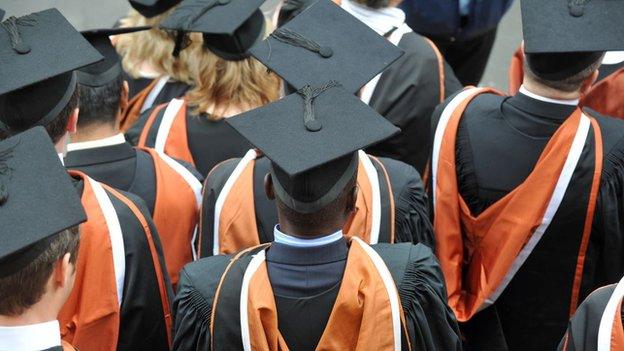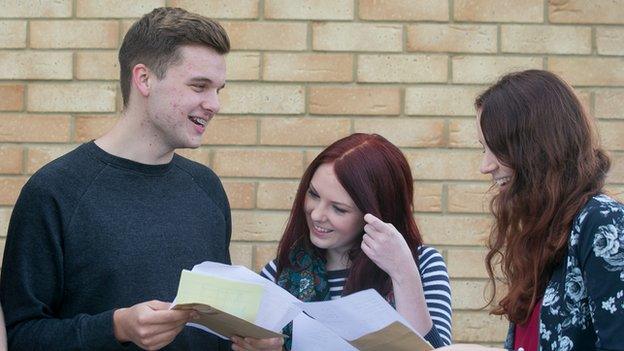Social mobility and university entry: Is access fair?
- Published

University of Bolton assistant vice-chancellor asks if universities can do more to support social mobility
The official closing date for standard university applications for 2015 entry has passed so it seems an appropriate moment to investigate whether the system of access to universities is fair, especially at selective institutions.
How successful are universities in supporting social mobility and could they do more?
In recent years, the issue of social mobility through higher education has been given particular political prominence by the Social Mobility and Child Poverty Commission, external set up by the Child Poverty Act 2010, chaired by Alan Milburn.
In 2013, the Commission's report Higher Education, The Fair Access Challenge, external pointed out that between 2002-03 and 2011-12 the percentage of state-educated students at Russell Group universities actually fell.
It famously stated that the odds of a child at a state secondary school, who was eligible for free school meals in Year 11, being admitted to Oxbridge by the age of 19 were almost 2,000 to one against.
By contrast, the odds of a privately educated child being admitted to Oxbridge were 20 to one.
Are there signs of progress on social mobility in universities?
A recent Ucas report on the pattern of applications and acceptances in the 2014 cycle indicated that overall more young people are going to university than ever with more than 500,000 applicants being admitted.
Statistically misleading
While the gap between disadvantaged and better-off students is narrowing, there is still a long way to go.
The report finds that only 3% of disadvantaged 18-year-olds enter "high tariff" universities (such as the Russell Group) compared with 21% of those from the most advantaged backgrounds.
Ucas data indicates that the most disadvantaged young applicants in England were 13% more likely to enter a selective institution in 2014 than in the previous year, and 40% more likely than in 2010.
But does this constitute good progress?
Commenting on the 2014 data, the universities fair access watchdog, the Office for Fair Access (Offa), pointed out, external that while the 40% increase is welcome, it is in some respects statistically misleading.
This is perhaps because, historically, very few people from the most disadvantaged backgrounds enter highly selective universities. To be precise, there were 4,040 entrants in 2014 compared with 3,105 in 2011.
In that context, the 40% increase amounts to less than one percentage point increase for the most disadvantaged group, from 2.3% to 3.2% overall. The Offa judgement is, in effect, "good, but could do better".

Children at state secondary schools had a 2,000 to one chance of entering Oxbridge, according to a report
Data on declining part-time and postgraduate students also suggest that less well-off students are missing out.
Can this slow progress be accelerated?
The Milburn Commission emphasised in an update report before Christmas that priorities for universities to boost social mobility should include working even more closely with schools and providing support on A-level and career choices.
Calibre of schools
The Commission also proposed that the Higher Education Funding Council for England (HEFCE) should support universities to establish regional university access networks.
In responding, HEFCE has this month set up National Networks for Collaborative Outreach, external (NNCO) for universities and colleges to collaborate to improve access to higher education.
With investment of £22m, the scheme involves more than 200 further and higher education institutions, reaching 4,300 secondary schools and colleges.
While most are regionally focused, some networks are specifically for care leavers, older learners and learners aspiring to progress to Oxford and Cambridge.
Perhaps most controversially however, the Milburn report also encouraged selective universities to admit 3,000 more qualified state school students and 1,400 more working-class students with high grades each year starting this year, given that recruitment caps have been lifted by the government for the 2015 intake.
In addition, the Commission calls for 5,000 more Free School Meals pupils to be admitted by all universities by 2020.
But selective universities do not fully accept the arguments of either the Commission or Offa, and worry that too much onus is being put on them and claim the challenges - and the means to address them - lie elsewhere. In a recent statement on social mobility, external they argue:
"The key reason why too few students from disadvantaged backgrounds even apply to leading universities is that they are not achieving the right grades in the right subjects at school.
"Universities can and do help - but we simply cannot solve these problems alone. School attainment, advice and aspirations must all be dramatically improved if we are to remove the real barriers to fair access."

The Russell Group says it will spend £160m a year on scholarships from 2015
This is a complex area with many disputes over the multiple causes and effects, including calibre of schools, family wealth, grades, outreach initiatives and bursaries. But research by the Centre for Analysis of Youth Transitions (Cayt) suggests, external that even when we compare like with like in terms of academic achievement, applicants from deprived backgrounds are often still less likely to get into high tariff universities.
The Russell Group point to the investment they are making in supporting access both from tuition fees and from other sources.
They argue out that in 2015-16, 20 Russell Group universities in England will spend £235m supporting students from less advantaged backgrounds.
This will involve more than £160m on scholarships, fee waivers and bursaries with a further £49m on outreach activities, including working with teachers and hosting summer schools and other access schemes.
Proposals that universities should perhaps apply a set of formulas to calculate a "real" academic potential index, using so-called contextual data, where, for example, applicants with high grades from schools with generally low A-level grades, would be uprated on an objective statistical basis, are strongly resisted by selective universities.
Wilful elitism
They say the true picture of an applicant can only be secured on a case-by-case basis by an experienced admissions tutor.
Also, they are concerned that having formulas would undermine the autonomy of universities in managing their own admissions, and in turn their independence in other areas.
In the higher education sector more generally, there is concern about defining improvements in social mobility solely in terms of the percentage of poor students attending elite institutions.
It is claimed that the hundreds of thousands of students from disadvantaged areas who attend other universities across the UK, sometimes rather than not attending university at all, is ultimately a much more powerful force for social change.
More profoundly perhaps, there is the view that there is something amiss in a society where a small number of elite universities serve as narrow gateways to the top jobs.
Should the debate not be about a fair system for access to the professions rather than securing fair access to an unfair filtering system?
Later in 2015, the Milburn Commission will be publishing research into the "black box" behind candidate selection and promotion in the professions and how this helps or hinders social mobility.

A 2010 report said the odds of a privately educated child being admitted to Oxbridge were 20 to one
Rather intriguingly the commission has also announced that it will be publishing research "why some people from advantaged backgrounds succeed in the labour market despite apparent low ability or few academic achievements" the so-called glass floor effect.
Since 1973, the Labour Force Survey, external has been surveying around 300,000 homes each year on education and work. Now for the first time it includes a number of questions on social mobility, looking, for example, at the occupation of respondents' parents.
This will help link social background to current achievement and work activity.
Paradoxically, higher education is unlikely to figure significantly in the 2015 general election because it appears none of the three main parties is confident it offers a clean historical record or attractive solution for future funding.
The Labour Party is indicating it is considering cutting tuition fees to £6,000 per annum from the current £9,000.
The debate has moved on from claims of social engineering versus wilful elitism.
But the numbers of working-class students at selective institutions appears stubbornly resistant to change - for whatever reason.
There is a broad political consensus on the need for fairer access to university and top jobs, however, given the complexity of the factors involved, the political nature of the arguments, and the direct links to the future social and economic success of the UK, debates over social mobility, and the role of universities in supporting it, will continue throughout 2015, and well beyond.
- Published26 January 2011
- Published19 December 2014

- Published15 August 2014
